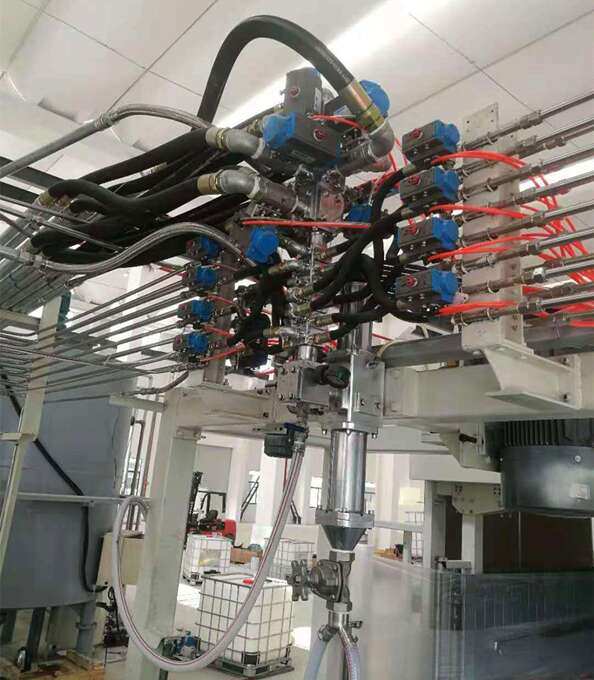Horizontal foam continuous foaming technology of PU foam
Sponge automatic horizontal continuous foam production line is mainly suitable for soft polyurethane sponge production in the density range of 7-160kg/m3.
The machine adopts the high degree of automation, master more flexible man-machine interface control system, (the machine are: since the hand control and automatic man-machine interface two configurations are available) users can store 200 different formula, also can adjust formula or changes at any time, and may carry out remote control via the Internet, which controls the cost of production is more scientific and intuitive.The equipment can directly change the formula without stopping the machine, without measuring the flow, the yellow resistance can reach the level 3 international standard, used for the production of various ideal furniture sponge, shoe material sponge, chest sponge, electronic sponge, as well as suitable for packaging, clothing and automobile industry used sponge.
Provide training on formula and foaming technology as required. .
First, storage tank:
the size of the storage tank should be related to the foaming field equipment, the tank is too big, too small, too thick, too fine will increase the adverse factors of foaming.Two, pump:
the size of the pump is related to the range of foaming flow and the diameter of the output tube. The output per revolution is the main parameter of the gear pump.Three, pipeline:
must be matched with the flow range and pump size.Four, steering valve:
that is, when the action of the raw material into the mixing chamber or into the backflow pipe. Note that the steering valve of powder and TDI components is easy to freeze or not open in place.
5. Mixing chamber:
its diameter and length are important parameters and also the basis for calculation.
Six, casting:
in line with the principle of uniform and continuous. The swing frequency, conveyor belt speed and foam start speed should be coordinated.
Seven, overflow tank:
the tank volume 20-60 liters, the tank volume determines the residence time of raw materials in the tank.
Eight, settlement plate:
if the foaming bottom plate of the assembly line is a straight line, the conveyor belt is opened, this is the upper part of the bubble is a curve, in turn, put the curve on the bottom plate of the assembly line, the upper part of the bubble is a straight line, this is the principle of the flat top of the settlement plate, but also the basis of the adjustment of the settlement plate. The drop and length of the settling plate are the main parameters, which must be coordinated with the conveyor belt speed and viscosity change of the reaction system.
Nine, stirring speed:
with foaming internal pressure, flow, formula reaction speed. Usually 4000-5000 RPM.
Ten, air:
air increases, the bubble hole has a tendency to thin, but the air increases to a certain amount of the bubble hole is not fine and the bean hole, so it should be accurately mastered, usually 50-150.
Eleven, foaming pressure:
the increase of pressure will strengthen the shear force of mixing, will eliminate the number of initial nucleation points and make the bubble hole thicker. Usually 1.8 to 2.4 atmospheres.
TDI delay:
TDI later spit out time, to prevent the bubble head heartburn. It is usually set to 0.1-1 seconds.
Thirteen, conveyor belt speed:
related to the starting speed and settlement plate. Pendulum hair on the conveyor belt speed requirements are more stringent.
(A) The production of polyurethane foam needs to balance two main chemical reactions: the gelation reaction of A polyether polyol and isocyanate (catalyzed by stannous octanate catalyst) and the gas generation reaction of water and isocyanate (catalyzed by tertiary amine catalyst). The two reactions must be carried out smoothly at the same time and balanced at the completion of the reaction, so as to produce a good quality foam.
(2) When foaming reaction is carried out, the key is to control the viscosity of the material, and the speed of viscosity growth is the speed of chain growth. When the viscosity increases too fast, the bubbles are solidified before the foaming reaction is completed, so that the density of the foam increases and the qualitative energy of the compression changes decreases. If the viscosity increases too slowly, the bubbles will escape before the foaming reaction is completed, which will lead to collapse and other phenomena, affecting the strength and tearing properties of the foam.
(3) From the performance requirements of the foam, it is necessary to balance the two main reactions: when the foaming reaction is completed, that is, the chain grows to the strength of the foam network to the extent that the bubble traps in.
(4) Foam auxiliaries include catalysts, stabilizers, foaming agents, flame retardants, etc. The following analysis is made for catalysts and stabilizers:
1, amine catalyst (mainly start gas reaction)
2, tin catalyst (mainly gel reaction)
3, silicone surfactant (mainly plays a stabilizing role)
Introduction of some abnormal phenomena and treatment methods in the foaming process:
1) Defect: bubble collapse after foam rises and develops to a certain height
Possible causes: A is bad or insufficient b Tin is bad or insufficient
Solution: check the quality and output of both pump output
2) Defects: foam top skin has a lump: the top skin is full of blowholes
Latest News
Contact Us

Name: Dylane shi/ Henry
E-mail: [email protected]
QQ: 627812212
WeChat: qd627812212
Whatsapp: +8618061811323
Whatsapp: +8613210076180
Add: Qingdao City, Shandong


 CHINESE
CHINESE ENGLISH
ENGLISH










 WhatsApp
WhatsApp  Mail inquiry
Mail inquiry QQ online
QQ online